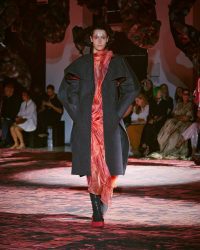There is growing awareness and concerns about the mountains of discarded garments that wind up in developing countries as Western economies attempt to outsource their waste disposal. Michael Walker looks at initiatives that aim to provide a more circular economy solution
Compared to paper, recycling of textiles is rather in its infancy. According to Texaid, a European organisation based in Switzerland for ‘the ecological collection, sorting and recycling of used textiles’, out of some 7.5 million tonnes of textiles discarded every year in Europe, only 30 – 35% are collected separately and of that quantity, only 15 – 20% are sorted by medium and larger sorting facilities within the EU. After sorting, 60% still qualify as wearable clothes, but after a second or third collection loop, all garment textiles become unwearable sooner or later.
As a result, it’s increasingly important to look at ways that outworn garments can be reused as a feedstock for the manufacture of new fabrics rather than down the value chain to alternative uses or worse – and more usually – incinerated or sent to landfill. Texaid notes that ‘the textile recycling value chain is not yet mature, but we are on the verge of a turning point, as different fibre-recycling technologies are deployed on a large scale’; it suggests that if the textile recycling industry could reach a recycling rate of 18 – 26% of gross textile waste in 2030, this could have an economic, social and environmental value in the range of €3.5 – €4.5 billion in that year.
A McKinsey report released in 2022, Scaling textile recycling in Europe – turning waste into value, was the source for these figures and the report further notes that CO2 emissions could be reduced by 4 million tons, as well as creating some 15,000 new jobs in Europe.
However, there is some work to do to get there. As with any type of recycling, segregation of materials into different types that suit the different recycling processes is one of the key requirements to operate cost-efficiently at scale. McKinsey states ‘Textile waste must be sorted using quality-oriented criteria, buttons and zippers removed, and fibre compositions clearly identified. Many products comprised of mixed fibres pose a problem for fibre-to-fibre recycling for which there is not yet a solution.’
While McKinsey estimates a total investment across the entire value chain of some €6 – €7 billion is needed, including development of new and existing processes for recycling/reclaiming materials as well as more sorting and recycling sites, it also suggests that a possible annual return of 20 to 25% could be achieved, so there should be a financial incentive as well as an environmental one.
Scaling up
Texaid has initiated a ‘transform textile waste into feedstock’ project which aims to deliver a ‘sorting factory’ blueprint to meet the needs of fibre-to-fibre recycling. The organisation has also committed to building and operating scalable sorting facilities across Europe, the first with a capacity of 50,000 tonnes, by the end of 2024.
‘This project will enable real scalable sorting in a sense of sorting 4.0,’ said Martin Böschen, CEO of Texaid. ‘In order to reach that target we are starting with a technology assessment, followed by a demo pant before going to full scale by the end of next year’. A wide range of companies including Concordia, CuRe Technology, Decathlon, Inditex, Indorama Ventures, L’Atelier des Matières, Lenzing, Marchi & Fildi, PurFi, Södra, Worn Again and others are taking part in the project to jointly evaluate technologies and the business case for scaled sorting for reuse and recycling.
A recent addition to the project is Avery Dennison, which already provides digital identification solutions for the apparel industry. The US company will work with Texaid to explore how ‘internet of things’ and RFID technology can enable traceability of garments onwards through the sorting and recycling process. This will involve the use of digital identifiers, which can be tracked via Avery Dennison’s atma.io connected product cloud platform. These identifiers will carry fibre information, which will help Texaid to sort apparel into the relevant resale or recycling streams.
This will also play into forthcoming EU regulation through its Strategy for Sustainable and Circular Textiles, which calls for textile products sold in the EU to be more durable, easier to reuse, repair and recycle. An important aspect of this is a mandatory minimum requirement for recycled content and the planned introduction of ‘digital product passports’ containing information about an item’s sustainability credentials. These are intended to help EU regulators impose disclosure requirements and provide more accountability for what happens to clothes that can’t be sold or are no longer wanted, though there has been criticism of details of the proposals from the European Apparel and Textile Confederation.
Michael Colarossi, vice president, innovation, product line management and sustainability, Apparel for Avery Dennison, said, ‘How do we turn textile waste into value at scale? The fashion industry needs answers and it needs action. This technology-driven approach will enable textile recycling, while also reducing processing time, driving down costs and increasing capacity.’
Small is beautiful

A recent collection by Yuima Nakazato was printed on dry fibre recycled material by Epson
Another approach is coming from printer manufacturer Epson, which is adapting a dry fibre recycling approach for paper to textile purposes. Like paper manufacture, paper recycling is a water-intensive process, and given the growing pressure to reduce water use in the fashion fabrics sector – an even bigger user of water – it looks like a sensible step to adapt a process that is at heart about the reclaiming of natural fibres (wood fibres in the case of paper) to retrieve and re-use textile fibres.
One result of this is 150m of dry fibre nonwoven fabrics used as part of Epson’s ongoing collaboration with Japanese fashion designer Yuima Nakazato, and which appeared in a recent collection presented in Paris. The recycled fabrics were printed on the company’s Monna Lisa pigment printers, which also reduce water usage compared to non-digital printing methods. This technology is very much at a proof-of-concept stage right now but Epson says it has been able to make the material thinner, more flexible and easier to print on.
Hitoshi Igarashi from Epson’s Printing Solutions Division explained, ‘Although in its early stages, Epson believes its dry fibre technology combined with pigment ink digital printing could offer the fashion industry a much more sustainable future, significantly reducing water use while allowing designers the freedom to fully express their creativity.’
He added that a new version of the Monna Lisa printer, the ML-13000, was essential to the development, saying, ‘The prototype ML-13000 is capable of printing not just ink, but also three different types of liquid onto fabric at the same time, thereby enhancing brilliance, durability and flexibility. Epson has utilised this printer to print on fabric with an optimised balance of ink and liquids.
‘This innovation achieves quick production, reducing water usage, and saving use of energy. This initiative shows how discarded garments can be upcycled into new types of clothing.’
Another experimental approach is the chemical recycling of dye-sublimated polyester-based fabrics by Mimaki, as previously reported from ITMA. Individually these might seem like small steps and it’s clear that there is a great deal to do collectively but attention, effort and innovation are being brought to bear on these challenges. As the adage goes, ‘don’t look at the mountain, climb it’.





